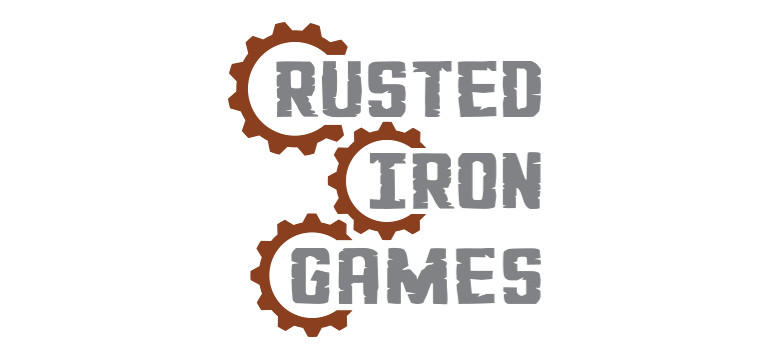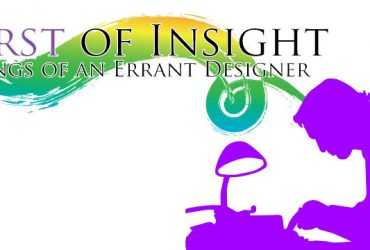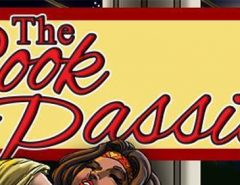Third Party People talks to the people behind the third party publishers that innovate new options for the Pathfinder Roleplaying Game and provide hungry young freelancers a venue. Today I speak with Russ Brown, owner of Rusted Iron Games.
RC: What is Rusted Iron Games all about?
RB: Rusted Iron Games is about finally doing something with all the game design ideas that I kept filing away to “do something with someday”. It has also turned out to have a lot to do with me teaching myself about game design and especially self publishing in the Pathfinder 3rd Party Publisher market. I want to put out high quality gaming products and for people to recognize R.I.G. as a quality brand. So far most of our products have been for Pathfinder with a few Fifth Edition products, but we also have rules for two different miniatures games in development.
RC: You are a Top 16 RPG Superstar quarterfinalist. How does your pre- and post-RPG Superstar design and publishing experience compare?
RB: That is an easy one. Prior to RPG Superstar I had no publishing experience and my only game design experience was as a GM for my home group designing homebrew settings and adventures. My most ambitious project was designing about 8-10 monster classes for a D&D 3.5 Savage Species campaign. In the two years since I placed in RPG Superstar, I have done freelancing for a handful of other companies including one assignment for Paizo and I have published 28 RPG products. Those are all short PDFs ranging from 5 to 14 pages in length.
RC: What inspired you to launch your own third party publishing company? What are your goals as a publisher?
RB: I think the inspiration is twofold. First, I guess I am not that good at pitching my ideas to other people since after the expected rejections, it just seemed a lot easier to go ahead and publish things myself instead of convincing someone else that my ideas were worth publishing. That is not to say there was not a huge learning curve. It is also why I started with short 5 page PDFs as my first products. If it was not for a friend who had the spare time to teach me the basics of InDesign, R.I.G. may never have gotten off the ground.
Second, I have to admit that I am a bit of a control freak and I really like having the final decision on how my ideas are presented in the products. I also sometimes find it hard to be inspired to work on someone else’s ideas, which freelancers have to do all the time. With my own ideas, I don’t usually have that issue.
As far as my goals as a publisher, my primary goal, as I said before, is to have Rusted Iron Games to be recognized as a quality brand and company. However, as a secondary goal, I want to provide a vehicle for new people to break into game design. Which is why, about 6 months after R.I.G. started I held an open call for people to pitch me monster ideas for our Deadly Gardens line. As you can imagine though, sometimes it can be challenging to balance these two goals.
RC: What three products embody Rusted Iron Games’ mission statement, and how?
RB: Since our products are very short, I am going to cheat a bit and go by product line. The first has to be our Deadly Gardens line. Each volume features a new plant monster. Since I was eliminated from RPG Superstar in the monster round after submitting a plant monster, my contrary nature obviously led me to decide to publish a whole book of awesome plant monsters just to show everyone that I could. The “whole book” part changed to the series of short PDFs along the way, but there are plans in the wings for a collected print book eventually. One thing that most people probably don’t know is that each volume also contains additional content (items mostly) that are usable by players and useful in wilderness/nature settings. Most of the volumes have received very positive reviews. Deadly Gardens: Blood Rose Swarm has four different 5 star reviews on the Paizo site.
For the second and third products I am going to say both the Character Options and Race Options lines. Mostly because this is another place where I held an open call for ideas to give anyone a chance to write an RPG product for R.I.G. I have one more Race Option volume and at least four Character Option volumes currently in development.
RC: How has Rusted Iron Games separated itself from the other third party publishers?
RB: First I think you have to put out quality products*. Secondly I think you have to pick an area or topic that is not overdone and will allow you to stand out more easily. This is why I picked Deadly Gardens as R.I.G.’s flagship line. There is not an overabundance of companies specifically putting out plant monsters and wilderness content. *This is not to say other publishers don’t put out quality products, because they absolutely do. There is a ton of great 3PP material out there for Pathfinder.
RC: How do you get attention in the crowded Pathfinder Third Party Publisher space?
RB: This is a great question, but one that is difficult for me to answer. Mostly because I am not completely sure that we have succeeded on this front yet. We have a small but loyal following of customers but I am always struggling to think of new ways to get people to notice our products. I am sure that having this interview on the Know Direction network will help, so thanks for giving me this opportunity.
RC: Everything Rusted Iron Games releases for Pathfinder is simultaneously released for 5th edition. What are the benefits and challenges of this business model?
RB: Actually we don’t actually do that. Only 3 of our Deadly Gardens products have been released for 5th edition. For whatever reason our 5th edition products have not sold all that well. I do plan on eventually converting all the Deadly Gardens monsters to 5th edition, but that will be a ways down the road and a lot of the other content in the series does not directly translate to 5th edition easily.
RC: What is your gaming background, and how did you come to be so invested in the Pathfinder RPG?
RB: I got started in RPGs early. My dad gave me the AD&D blue box (Blue, not red you whippersnappers! Get off my lawn!) for Christmas when I was in like 3rd grade. I was still a bit young then, so it sat on my bookshelf for a couple of years until I rediscovered it and started playing with the neighborhood kids when we were still in elementary school. I played rpgs all the way through highschool and college until I eventually played 2nd and 3rd edition with the same game group every Saturday for about 10 years. Life eventually broke that group up and when WotC released 4th edition I care for it so I started looking for alternatives and found Paizo and Pathfinder when the released it to replace 3.5. Since I still did not have a regular group, I got involved with organizing games for Pathfinder Society in 2010 and that really cemented my love for Pathfinder. Last month I just stepped down as Venture Captain of Denver in order to focus my time and attention more fully on R.I.G.
RC: What are the greatest challenges you face as a third party publisher of Pathfinder RPG content?
RB: Coming up with good ideas and then following through on those ideas to produce original and interesting designs. Ideas are actually the easy part, lots of people have great ideas but will never follow through and do something with them. One advantage a publisher has is when you have one of those really killer ideas, if you are too busy to work on it yourself you can hire a talented freelancer to turn that idea into a design for you.
RC: How do you ensure the highest quality possible for your products, from game balance and the writing to the artwork and graphic design?
RB: If you are not doing the work yourself, then hire quality people to do the work for you. After that care copy editing and checking every rules reference is key. If you are going to write or edit something about dragons, go re-read the material about dragons even if you think you already know it. They say you should never edit your own writing, but as a one-man operation I don’t usually have that luxury. So I leave anything I write for two days and then come back and edit it with relatively fresh eyes. Play testing is also key of course – a simple playtest can reveal design issues that are not apparent by theorycrafting alone. Lastly if you release products in PDF format do not be afraid to go back and fix any issues that come up from reviews or customer feedback. Your customers will appreciate it. For art, you just have to find artists whose style fits well with your products. I try to put at least one piece of original art in every product.
RC: How has being a third party publisher impacted your home game and other design work?
RB: Well since I am currently a player in my home game, I can’t just drop new (most likely plant) monsters into the game as a form of covert playtesting – because when it comes back to my turn to GM again that will totally happen. Instead I find myself mining the table talk for game design ideas. Since no one else in my group is involved in game design, when I am inspired or someone else drops a great idea I tell them point blank that I am stealing that idea. They always seem to think I am kidding even though most of those ideas turn up in R.I.G. products a few months down the line.
RC: What comes first: an idea or a mechanic?
RB: Both, it really depends on the situation. Sometimes you have the idea to make a wandering sundew plant that looks like a giant turtle or armadillo and wonder “what mechanics do I need to make that happen?” Other times you want to flex your evil monster design muscles and decide to make a monster that has DR/Slashing but also explosive regeneration that is triggered by piercing or slashing weapons and need to translate those mechanics into a specific kind of plant monster. You know, just to provide a couple of examples.
RC: What lessons have your experiences taught you about publishing?
RB: Creating high quality, professional products (even PDFs) is a lot of work! Saving a word document as a pdf and posting it on your blog is super simple. On the other hand, I don’t think most people appreciate how much work goes into producing a really good quality product. Myself included – when I first started I had no idea how much work was involved. Also quality artwork is worth the price, it will really improve the quality of a product as a whole.
RC: What do you look for in a freelancer, and where have you found your strongest freelancers?
RB: For writers/designers without a doubt the Paizo forums. Both in the RPG Superstar section and by placing open calls in the 3rd Party Publishing section. I just look for someone with an interesting idea and either design experience or who can provide a quality writing sample. I would say my strongest freelancers would be Jacob W. Michaels, Joe Kondrak, Jeff Gomez (Zenith Games) and of course RPG Superstar Mike Welham. For artists it has been both the Paizo site and a mix of RL connections. For artists I just ask for a link to an online portfolio of some kind. If I like their portfolio I will give them an assignment to work on. My strongest artists include Liz Courts, Keith Wood, Graeme Cunningham and Jeremy Corff.
RC: If you could change one thing about Pathfinder, what would it be?
RB: Well as game designers we are always changing and adding things to the game of course. However, if I could change one fundamental aspect of the game (this applies to D&D as well), I think it would be people’s perception of the cleric class. There is the old stereotype that all the cleric is about is healing people and that is all they can do. While that is important you can make all different types of clerics with all different types of abilities.
RC: What is a highlight of your experience as a third party publisher?
RB: Getting that first great review. Endzeitgeist rated my first product Deadly Gardens: Phoenix Lily as 5 stars + Seal of Approval. That felt really great and gave me some validation that this whole publishing thing was not a totally insane choice.
RC: One day you wake up and all your goals for Rusted Iron Games have been met. What does that day look like, and where do you go from there?
RB: I don’t know if all my goals for Rusted Iron Games could ever be met. They say that successful people always set new goals once a current goal has been achieved so that you avoid becoming complacent or stagnant. However being in a place where I could work on R.I.G. game design projects full time and still pay my bills and mortgage and afford to eat would be pretty awesome. One of my current goals is that all RPG players should have rustedirongames.com bookmarked in their browsers – you can do your part to help me with that goal today! *wink*





